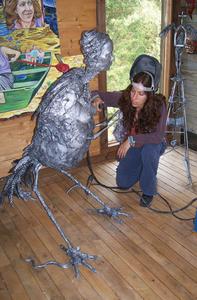

One of the artists selected for the 2007 show, Mary Tartaro, puts the finishing touches on one of her sculptures.
"From These Hills: Contemporary Art in the Southern Appalachian Highlands" officially opens with a reception from 7-9 p.m. Friday, June 29 at William King Regional Arts Center in Abingdon, Va.
This year's curator, Dr. Howard Risatti, continues the long history of top-notch scholars of 20th-century art who have been responsible for the series' consistent approach to innovative excellence. Risatti is professor emeritus of art history at Virginia Commonwealth University. His latest book, A Theory of Craft: Function and Aesthetic Expression, will be released in the fall. Other books include Skilled Work: American Craft in the Renwick Gallery and Postmodern Perspectives: Issues in Contemporary Art.
Previous curators took the jurying process a step beyond the initial slide review by making visits to artists' studios or asking artists to bring their artworks to the Arts Center in order to review their work more completely.
Even though time didn't permit this year's juror to visit the studios, WKRAC Executive Director Betsy White says Risatti "spent an enormously long time" poring over the artists' slides. Risatti said slides were submitted by 53 artists whose studios are scattered from Asheville, N.C. to Roanoke, Va. Of those 53, 18 were selected for this show.
White said she hopes the next curator will be able to visit artists' studios and/or view original artworks at the Arts Center. She recalled, "When Andrea Poland curated the exhibit two years ago, I escorted her to artists' studios. I could see how important that was for her as well as the artists. She was seeing them in their studios and the body of their work. Those personal meetings were real connections. When she went back to Washington, D.C., she had a much broader knowledge of the artists in our region, which is one of the most important services the Arts Center can offer."
According to White, "The purpose of the competitive show was and remains today two-fold: to showcase artistic trends in the region and to provide the region's artists with opportunities for professional growth through, not only the exhibition and its catalog, but also through contact with the guest curator and the resulting potential for wider exposure of their work."
"From These Hills" Boosted Careerof Local Artist to a National Level
Suzanne Stryk of Bristol, Va. has been selected for "From These Hills" multiple times, which she said "gave me incredible opportunities." Curators who selected her works for "From These Hills" later invited her to do shows in other parts of the country. Today her artworks are seen throughout the U.S. more often than in her own region.
As an artist, she greatly appreciated "the incredible talks" she had with previous curators. "Their comments have helped me in my work," she said, "and their visits were some of the most exceptional experiences in my life. With their help, I really honed a lot of my skills."
She noted that, "without personal visits, if curators don't know you and your work, all they have to go by are the slides you submit."
According to Stryk, Carolyn Eyler, the first curator of William King, wanted "From These Hills" to be different from "just another juried show." Stryk explained, "She tried it a few different ways, with curators selecting work after making rounds of studios, then another time she had selected artists bring work to the Arts Center where the final show was chosen. Katy Charles followed this tradition, and so did Tom Perryman and Matt Mangold."
Stryk continued, "It was interesting to meet the various curators and hear their take on the art, react to that interpretation (or decide whether they were being really honest), and then have a very personally selected show. I think Terrie Sultan did the very best job because her gutsy selection reflected the idiosyncratic best of the region -- warts and wonders and all. That's my preference, so whether I'm in the show or not, I like some blood and personality in an exhibit. I don't particularly care for exhibits that try to mimic the New York art world or find all the artists in the region whose work matches national trends."
Related Stories: